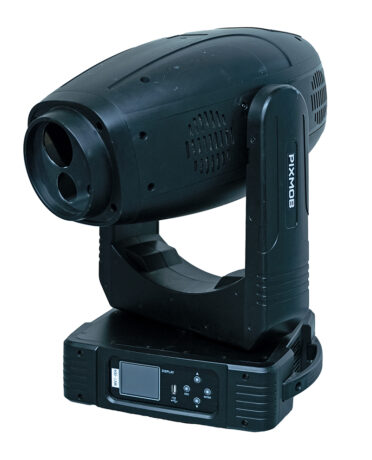
Many know the name of Montreal based PixMob for their LED wristbands that are deployed for concert tours, and large-scale events like the Super Bowl Halftime show. PixMob’s technology uses infrared to light up RGB LEDs that are embedded in different objects such as audience wristbands and wearable objects, given to the audience, to transform everyone in attendance into a pixel so that the whole venue can become a canvas for light art. PixMob has now added a new product to their line which will add yet another layer to the visual pixel mapped art landscape.
The PixMob Moving Visual Transmitter (MVT)
The MVT will now let creatives have images such as stars dancing over the audience and lifelike waves can flow through the spectators. PixMob’s Moving Visual Transmitter uses a moving head fixture body, that’s designed to project infrared light. Instead of casting a beam of infrared light on a single location, the MVT can send multiple commands to different locations at once. The unit has an integrated infrared camera that allows PixMob’s system to visualize positions and programming without the need to deploy any additional devices.
The MVT delivers unique custom graphics over the audience, offering animated textures, patterns, logos, text animations, and more. Since the MVT can pan and tilt, these visuals can either stay fixed in one section of the audience or animate across it, transforming the crowd into a massive dynamic display. Plus, the MVT easily integrates into existing setups. The system includes the required video control station and media server, with content control managed through the media server. It can be self-contained; or take triggers from a show control system or lighting console.
The Details
PLSN spoke with Jean-Olivier Dalphond, Founding Partner, and Chief Commercial Officer of PixMob to learn more about the new Moving Visual Transmitter. “With this technology, we’re able to control each object in space individually,” he explains. “Each transmitter sends out 700,000 geolocated data instruction points for wristbands, or any PixMob object, to interpret. This lets us create moving graphics in an audience in a very simple execution. With the audience as the canvas, you can use MVT to send IR signals and then layer on graphics that can move across the colored background.”
In the past, the PixMob system—whether a moving head or global transmitter—sent a unified beam of data. Now, Dalphond says, the MVT can be sending 700,000 different infrared beams. “It’s important to be able to control every pixel in real time. There’s nothing programmed on the pixel. Essentially, we’re beaming video through a lot of beams of infrared light. The MVT is a way to use an infrared laser through a DLP to send video images through infrared data. The innovation here for PixMob was coming up with a protocol to do all that.” He continues, “It’s a fairly lightweight operation because we just send out graphics. We have our own servers, but the MVT system can be completely integrated into a touring setup. It can be fully seamless or totally independent.”
Dalphond describes some of the applications for PixMob MVT. “Imagine being in a stadium, on a tour, and you can start showing moving graphics that create more impact,” he says. “Instead of just being colors or waves, now you can show shapes that amplify the narrative that the artist wants to bring in the audience. It could be showing a dollar sign, or it could be showing an important number, or an airplane or spaceship flying around the stadium.”
For PixMob, pioneers of audience wearable controlled effects, Dalphond points out, “This is the next evolution where we just don’t stop pushing what pixels—and an audience—can do. We keep increasing that sense of joy that people feel; that sense of amazement. They’re like, ‘Wow, I’m really part of something larger than myself.’”

For further information about PixMob and the new MVT vist www.pixmob.com.


